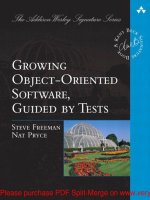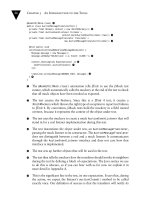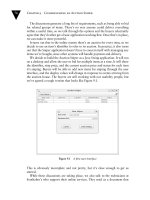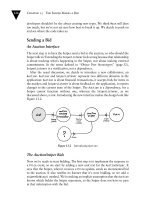Tài liệu Growing Object-Oriented Software, Guided by Tests- P1 pptx
Bạn đang xem bản rút gọn của tài liệu. Xem và tải ngay bản đầy đủ của tài liệu tại đây (690.77 KB, 50 trang )
ptg
From the Library of Lee Bogdanoff
Please purchase PDF Split-Merge on www.verypdf.com to remove this watermark.
ptg
Praise for Growing Object-Oriented Software, Guided by Tests
“The authors of this book have led a revolution in the craft of programming by controlling
the environment in which software grows. Their Petri dish is the mock object, and their
microscope is the unit test. This book can show you how these tools introduce a
repeatability to your work that would be the envy of any scientist.”
—Ward Cunningham
“At last a book, suffused with code, that exposes the deep symbiosis between TDD and
OOD. The authors, pioneers in test-driven development, have packed it with principles,
practices, heuristics, and (best of all) anecdotes drawn from their decades of professional
experience. Every software craftsman will want to pore over the chapters of worked
examples and study the advanced testing and design principles. This one’s a keeper.”
—Robert C. Martin
“Design is often discussed in depth, but without empiricism. Testing is often promoted,
but within the narrow definition of quality that relates only to the presence or absence of
defects. Both of these perspectives are valuable, but each on its own offers little more than
the sound of one hand clapping. Steve and Nat bring the two hands together in what
deserves—and can best be described as—applause. With clarity, reason, and humour,
their tour de force reveals a view of design, testing, code, objects, practice, and process
that is compelling, practical, and overflowing with insight.”
—Kevlin Henney, co-author of Pattern-Oriented Software Architecture
and 97 Things Every Programmer Should Know
“Steve and Nat have written a wonderful book that shares their software craftsmanship
with the rest of the world. This is a book that should be studied rather than read, and
those who invest sufficient time and energy into this effort will be rewarded with superior
development skills.”
—David Vydra, publisher, testdriven.com
“This book presents a unique vision of test-driven development. It describes the mature
form of an alternative strain of TDD that sprang up in London in the early 2000s,
characterized by a totally end-to-end approach and a deep emphasis on the messaging
aspect of objects. If you want to be an expert in the state of the art in TDD, you need to
understand the ideas in this book.”
—Michael Feathers
“With this book you’ll learn the rhythms, nuances in thinking, and effective programming
practices for growing tested, well-designed object-oriented applications from the masters.”
—Rebecca Wirfs-Brock
From the Library of Lee Bogdanoff
Please purchase PDF Split-Merge on www.verypdf.com to remove this watermark.
ptg
This page intentionally left blank
From the Library of Lee Bogdanoff
Please purchase PDF Split-Merge on www.verypdf.com to remove this watermark.
ptg
Growing
Object-Oriented
Software,
Guided
by Tests
From the Library of Lee Bogdanoff
Please purchase PDF Split-Merge on www.verypdf.com to remove this watermark.
ptg
T
he Addison-Wesley Signature Series provides readers with
practical and authoritative information on the latest trends in modern
technology for computer professionals. The series is based on one simple
premise: Great books come from great authors. Books in the series are
personally chosen by expert advisors, world-class authors in their own
right. These experts are proud to put their signatures on the covers, and
their signatures ensure that these thought leaders have worked closely
with authors to define topic coverage, book scope, critical content, and
overall uniqueness. The expert signatures also symbolize a promise to
our readers: You are reading a future classic.
Visit informit.com/awss for a complete list of available products.
The Addison-Wesley
Signature Series
Kent Beck, Mike Cohn, and Martin Fowler, Consulting Editors
From the Library of Lee Bogdanoff
Please purchase PDF Split-Merge on www.verypdf.com to remove this watermark.
ptg
Growing
Object-Oriented
Software,
Guided
by Tests
Steve Freeman and Nat Pryce
Upper Saddle River, NJ • Boston • Indianapolis • San Francisco
New York • Toronto • Montreal • London • Munich • Paris • Madrid
Cape Town • Sydney • Tokyo • Singapore • Mexico City
From the Library of Lee Bogdanoff
Please purchase PDF Split-Merge on www.verypdf.com to remove this watermark.
ptg
Many of the designations used by manufacturers and sellers to distinguish their products are claimed
as trademarks. Where those designations appear in this book, and the publisher was aware of a
trademark claim, the designations have been printed with initial capital letters or in all capitals.
The authors and publisher have taken care in the preparation of this book, but make no expressed
or implied warranty of any kind and assume no responsibility for errors or omissions. No liability
is assumed for incidental or consequential damages in connection with or arising out of the use of
the information or programs contained herein.
The publisher offers excellent discounts on this book when ordered in quantity for bulk purchases
or special sales, which may include electronic versions and/or custom covers and content particular
to your business, training goals, marketing focus, and branding interests. For more information,
please contact:
U.S. Corporate and Government Sales
(800) 382–3419
For sales outside the United States please contact:
International Sales
Visit us on the Web: informit.com/aw
Library of Congress Cataloging-in-Publication Data:
Freeman, Steve, 1958-
Growing object-oriented software, guided by tests / Steve Freeman and Nat Pryce.
p. cm.
ISBN 978-0-321-50362-6 (pbk. : alk. paper) 1. Object-oriented programming
(Computer science) 2. Computer software--Testing. I. Pryce, Nat. II. Title.
QA76.64.F747 2010
005.1'17--dc22
2009035239
Copyright © 2010 Pearson Education, Inc.
All rights reserved. Printed in the United States of America. This publication is protected by
copyright, and permission must be obtained from the publisher prior to any prohibited reproduction,
storage in a retrieval system, or transmission in any form or by any means, electronic, mechanical,
photocopying, recording, or likewise. For information regarding permissions, write to:
Pearson Education, Inc
Rights and Contracts Department
501 Boylston Street, Suite 900
Boston, MA 02116
Fax (617) 671 3447
ISBN-13: 978–0–321–50362–6
ISBN-10: 0–321–50362–7
Text printed in the United States on recycled paper at RR Donnelley in Crawfordsville, Indiana.
First printing October 2009
From the Library of Lee Bogdanoff
Please purchase PDF Split-Merge on www.verypdf.com to remove this watermark.
ptg
To Paola, for all her support; to Philip, who sometimes missed out
—Steve
To Lamaan who put up with me spending time writing this book,
and Oliver Tarek who did not
—Nat
From the Library of Lee Bogdanoff
Please purchase PDF Split-Merge on www.verypdf.com to remove this watermark.
ptg
This page intentionally left blank
From the Library of Lee Bogdanoff
Please purchase PDF Split-Merge on www.verypdf.com to remove this watermark.
ptg
Contents
xvForeword ......................................................................................................
xviiPreface ........................................................................................................
xxiAcknowledgments .......................................................................................
xxiiiAbout the Authors ....................................................................................
1Part I: Introduction .........................................................................................
3Chapter 1: What Is the Point of Test-Driven Development? .....................
3Software Development as a Learning Process .....................................
4Feedback Is the Fundamental Tool ....................................................
5Practices That Support Change ..........................................................
6Test-Driven Development in a Nutshell .............................................
7The Bigger Picture .............................................................................
8Testing End-to-End ............................................................................
9Levels of Testing ................................................................................
10External and Internal Quality ..........................................................
13Chapter 2: Test-Driven Development with Objects ................................
13A Web of Objects ............................................................................
13Values and Objects ..........................................................................
14Follow the Messages ........................................................................
17Tell, Don’t Ask ................................................................................
17But Sometimes Ask ..........................................................................
18Unit-Testing the Collaborating Objects ...........................................
19Support for TDD with Mock Objects ..............................................
ix
From the Library of Lee Bogdanoff
Please purchase PDF Split-Merge on www.verypdf.com to remove this watermark.
ptg
21Chapter 3: An Introduction to the Tools ................................................
21Stop Me If You’ve Heard This One Before ......................................
21A Minimal Introduction to JUnit 4 ..................................................
24Hamcrest Matchers and assertThat() ...............................................
25jMock2: Mock Objects ....................................................................
29Part II: The Process of Test-Driven Development .........................................
31Chapter 4: Kick-Starting the Test-Driven Cycle .....................................
31Introduction ....................................................................................
32First, Test a Walking Skeleton .........................................................
33Deciding the Shape of the Walking Skeleton ....................................
35Build Sources of Feedback ...............................................................
36Expose Uncertainty Early ................................................................
39Chapter 5: Maintaining the Test-Driven Cycle .......................................
39Introduction ....................................................................................
39Start Each Feature with an Acceptance Test ....................................
40
Separate Tests That Measure Progress from Those That Catch
Regressions ......................................................................................
41Start Testing with the Simplest Success Case ....................................
42Write the Test That You’d Want to Read ........................................
42Watch the Test Fail ..........................................................................
43Develop from the Inputs to the Outputs ..........................................
43Unit-Test Behavior, Not Methods ....................................................
44Listen to the Tests ............................................................................
45Tuning the Cycle .............................................................................
47Chapter 6: Object-Oriented Style ...........................................................
47Introduction ....................................................................................
47Designing for Maintainability ..........................................................
50Internals vs. Peers ............................................................................
51No And’s, Or’s, or But’s ..................................................................
52Object Peer Stereotypes ...................................................................
53Composite Simpler Than the Sum of Its Parts ..................................
54Context Independence .....................................................................
55Hiding the Right Information ..........................................................
56An Opinionated View ......................................................................
57Chapter 7: Achieving Object-Oriented Design .......................................
57How Writing a Test First Helps the Design .....................................
58Communication over Classification .................................................
Contents
x
From the Library of Lee Bogdanoff
Please purchase PDF Split-Merge on www.verypdf.com to remove this watermark.
ptg
59Value Types .....................................................................................
60Where Do Objects Come From? ......................................................
63Identify Relationships with Interfaces ..............................................
63Refactor Interfaces Too ...................................................................
64Compose Objects to Describe System Behavior ...............................
65Building Up to Higher-Level Programming ......................................
67And What about Classes? ................................................................
69Chapter 8: Building on Third-Party Code ..............................................
69Introduction ....................................................................................
69Only Mock Types That You Own ...................................................
71Mock Application Objects in Integration Tests ................................
73Part III: A Worked Example .........................................................................
75Chapter 9: Commissioning an Auction Sniper ........................................
75To Begin at the Beginning ................................................................
78Communicating with an Auction .....................................................
79Getting There Safely ........................................................................
81This Isn’t Real .................................................................................
83Chapter 10: The Walking Skeleton ........................................................
83Get the Skeleton out of the Closet ...................................................
84Our Very First Test ..........................................................................
86Some Initial Choices ........................................................................
89Chapter 11: Passing the First Test ..........................................................
89Building the Test Rig .......................................................................
95Failing and Passing the Test .............................................................
102The Necessary Minimum ...............................................................
105Chapter 12: Getting Ready to Bid ........................................................
105An Introduction to the Market ......................................................
106A Test for Bidding .........................................................................
112The AuctionMessageTranslator .....................................................
118Unpacking a Price Message ............................................................
121Finish the Job .................................................................................
123Chapter 13: The Sniper Makes a Bid ...................................................
123Introducing AuctionSniper .............................................................
126Sending a Bid .................................................................................
131Tidying Up the Implementation .....................................................
xi
Contents
From the Library of Lee Bogdanoff
Please purchase PDF Split-Merge on www.verypdf.com to remove this watermark.
ptg
136Defer Decisions ..............................................................................
137Emergent Design ............................................................................
139Chapter 14: The Sniper Wins the Auction ............................................
139First, a Failing Test ........................................................................
140Who Knows about Bidders? ...........................................................
143The Sniper Has More to Say ..........................................................
144The Sniper Acquires Some State .....................................................
146The Sniper Wins ............................................................................
148Making Steady Progress .................................................................
149Chapter 15: Towards a Real User Interface .........................................
149A More Realistic Implementation ..................................................
152Displaying Price Details .................................................................
159Simplifying Sniper Events ...............................................................
164Follow Through .............................................................................
168Final Polish ....................................................................................
171Observations ..................................................................................
175Chapter 16: Sniping for Multiple Items ................................................
175Testing for Multiple Items .............................................................
183Adding Items through the User Interface ........................................
189Observations ..................................................................................
191Chapter 17: Teasing Apart Main .........................................................
191Finding a Role ...............................................................................
192Extracting the Chat ........................................................................
195Extracting the Connection .............................................................
197Extracting the SnipersTableModel .................................................
201Observations ..................................................................................
205Chapter 18: Filling In the Details .........................................................
205A More Useful Application ............................................................
205Stop When We’ve Had Enough ......................................................
212Observations ..................................................................................
215Chapter 19: Handling Failure ...............................................................
215What If It Doesn’t Work? ..............................................................
217Detecting the Failure ......................................................................
218Displaying the Failure ....................................................................
219Disconnecting the Sniper ................................................................
221Recording the Failure .....................................................................
225Observations ..................................................................................
Contents
xii
From the Library of Lee Bogdanoff
Please purchase PDF Split-Merge on www.verypdf.com to remove this watermark.
ptg
227Part IV: Sustainable Test-Driven Development ...........................................
229Chapter 20: Listening to the Tests ........................................................
229Introduction ...................................................................................
230I Need to Mock an Object I Can’t Replace (without Magic) ..........
233Logging Is a Feature .......................................................................
235Mocking Concrete Classes .............................................................
237Don’t Mock Values ........................................................................
238Bloated Constructor .......................................................................
240Confused Object ............................................................................
241Too Many Dependencies ...............................................................
242Too Many Expectations .................................................................
244What the Tests Will Tell Us (If We’re Listening) ............................
247Chapter 21: Test Readability ...............................................................
247Introduction ...................................................................................
248Test Names Describe Features .......................................................
251Canonical Test Structure ................................................................
252Streamline the Test Code ...............................................................
254Assertions and Expectations ..........................................................
255Literals and Variables ....................................................................
257Chapter 22: Constructing Complex Test Data .....................................
257Introduction ...................................................................................
258Test Data Builders .........................................................................
259Creating Similar Objects ................................................................
261Combining Builders .......................................................................
261Emphasizing the Domain Model with Factory Methods ................
262Removing Duplication at the Point of Use .....................................
264Communication First .....................................................................
267Chapter 23: Test Diagnostics ...............................................................
267Design to Fail .................................................................................
268Small, Focused, Well-Named Tests ................................................
268Explanatory Assertion Messages ....................................................
268Highlight Detail with Matchers .....................................................
269Self-Describing Value .....................................................................
270Obviously Canned Value ...............................................................
270Tracer Object .................................................................................
271Explicitly Assert That Expectations Were Satisfied ........................
271Diagnostics Are a First-Class Feature .............................................
xiii
Contents
From the Library of Lee Bogdanoff
Please purchase PDF Split-Merge on www.verypdf.com to remove this watermark.
ptg
273Chapter 24: Test Flexibility ..................................................................
273Introduction ...................................................................................
274Test for Information, Not Representation ......................................
275Precise Assertions ...........................................................................
277Precise Expectations .......................................................................
284“Guinea Pig” Objects ....................................................................
287Part V: Advanced Topics ............................................................................
289Chapter 25: Testing Persistence ............................................................
289Introduction ...................................................................................
290Isolate Tests That Affect Persistent State ........................................
292Make Tests Transaction Boundaries Explicit .................................
294Testing an Object That Performs Persistence Operations ...............
297Testing That Objects Can Be Persisted ...........................................
300But Database Tests Are S-l-o-w! ....................................................
301Chapter 26: Unit Testing and Threads .................................................
301Introduction ...................................................................................
302Separating Functionality and Concurrency Policy ..........................
306Unit-Testing Synchronization .........................................................
311Stress-Testing Passive Objects ........................................................
312Synchronizing the Test Thread with Background Threads .............
313The Limitations of Unit Stress Tests ...............................................
315Chapter 27: Testing Asynchronous Code .............................................
315Introduction ...................................................................................
316Sampling or Listening ....................................................................
318Two Implementations ....................................................................
322Runaway Tests ..............................................................................
323Lost Updates ..................................................................................
325Testing That an Action Has No Effect ...........................................
326Distinguish Synchronizations and Assertions .................................
326Externalize Event Sources ..............................................................
329Afterword: A Brief History of Mock Objects ..............................................
335Appendix A: jMock2 Cheat Sheet ...............................................................
343Appendix B: Writing a Hamcrest Matcher .................................................
347Bibliography ...............................................................................................
349Index ..........................................................................................................
Contents
xiv
From the Library of Lee Bogdanoff
Please purchase PDF Split-Merge on www.verypdf.com to remove this watermark.
ptg
Foreword
Kent Beck
One of the dilemmas posed by the move to shorter and shorter release cycles is
how to release more software in less time—and continue releasing indefinitely.
A new perspective is necessary to resolve this dilemma. More than a shift in
techniques is needed.
Growing Object-Oriented Software, Guided by Tests presents such a new per-
spective. What if software wasn’t “made,” like we make a paper airplane—finish
folding it and fly it away? What if, instead, we treated software more like a
valuable, productive plant, to be nurtured, pruned, harvested, fertilized, and
watered? Traditional farmers know how to keep plants productive for decades
or even centuries. How would software development be different if we treated
our programs the same way?
I am most impressed by how this book presents both the philosophy and
mechanics of such a shift in perspective. It is written by practitioners who
code—and teach others to code—well. From it you can learn both how to program
to sustain productivity and how to look at your programs anew.
The style of test-driven development presented here is different from what I
practice. I can’t yet articulate the difference, but I have learned from the clear,
confident presentation of the authors’ techniques. The diversity of dialects has
given me a new source of ideas to further refine my own development. Growing
Object-Oriented Software, Guided by Tests, presents a coherent, consistent system
of development, where different techniques support each other.
I invite you to read Growing Object-Oriented Software, Guided by Tests,
to follow along with the examples, to learn how the authors think about
programming and how they program. The experience will enrich your software
development style, help you program—and, just as important, see your programs
differently.
xv
From the Library of Lee Bogdanoff
Please purchase PDF Split-Merge on www.verypdf.com to remove this watermark.
ptg
This page intentionally left blank
From the Library of Lee Bogdanoff
Please purchase PDF Split-Merge on www.verypdf.com to remove this watermark.
ptg
Preface
What Is This Book About?
This book is a practical guide to the best way we’ve found to write object-oriented
software: test-driven development (TDD). It describes the processes we follow,
the design principles we strive for, and the tools we use. It’s founded on our
decades of experience, working with and learning from some of the best
programmers in the world.
Within the book, we address some of the questions and confusions we see
coming up on project after project. How do I fit test-driven development into a
software project? Where do I start? Why should I write both unit and end-to-end
tests? What does it mean for tests to “drive” development? How do I test difficult
feature X?
This book is also very much about design and the way our approach to design
informs our approach to TDD. If there’s one thing we’ve learned, it’s that test-
driven development works best when taken as a whole. We’ve seen teams that
can do the raw practices (writing and running tests) but struggle with the result
because they haven’t also adopted the deeper processes that lie behind it.
Why “Growing” Object-Oriented Software?
We used the term “growing” because it gives a sense of how we develop incre-
mentally. We have something working at all times, making sure that the code is
always as well-structured as possible and thoroughly tested. Nothing else seems
to be as effective at delivering systems that work. As John Gall wrote in [Gall03],
“A complex system that works is invariably found to have evolved from a simple
system that works.”
“Growing” also hints at the biological quality we see in good software, the
sense of coherence at every level of structure. It ties into our approach to object
xvii
From the Library of Lee Bogdanoff
Please purchase PDF Split-Merge on www.verypdf.com to remove this watermark.
ptg
orientation which follows Alan Kay’s
1
concept of objects being similar to
biological cells that send each other messages.
Why “Guided” by Tests?
We write tests first because we find that it helps us write better code. Writing a
test first forces us to clarify our intentions, and we don’t start the next piece of
work until we have an unambiguous description of what it should do. The process
of writing a test first helps us see when a design is too rigid or unfocused. Then,
when we want to follow through and fix a design flaw, the tests give us a safety
net of regression coverage.
We use the term “guided” because the technique still requires skill and
experience. We found test-driven development to be an effective design support
tool—once we’d learned how to develop incrementally and to “listen to the tests.”
Like any serious design activity, TDD requires understanding and sustained effort
to work.
We’ve seen teams that write tests and code at about the same time (and even
teams that write the tests first) where the code is a mess and the tests just raise
the cost of maintenance. They’d made a start but hadn’t yet learned that the trick,
as the title of the book suggests, is to let the tests guide development. Use the
contents of the tests to stay focused on making progress and feedback from
the tests to raise the quality of the system.
What about Mock Objects?
Our original motivation for writing the book was to finally explain the technique
of using mock objects,
2
which we often see misunderstood. As we got deeper
into writing, we realized that our community’s discovery and use of mock objects
was actually an expression of our approach to writing software; it’s part of a
larger picture.
In the course of the book, we will show how the mock objects technique works,
using the jMock library. More specifically, we’ll show where it fits into the TDD
process and how it makes sense in the context of object-oriented development.
Who Is This Book For?
We wrote this book for the “informed reader.” It’s intended for developers
with professional experience who probably have at least looked at test-driven
1. Alan Kay was one of the authors of Smalltalk and coined the term “object-oriented.”
2. Mock objects are substitute implementations for testing how an object interacts with
its neighbors.
Preface
xviii
From the Library of Lee Bogdanoff
Please purchase PDF Split-Merge on www.verypdf.com to remove this watermark.
ptg
development. When writing, we imagined we were explaining techniques to a
colleague who hadn’t come across them before.
To make room for the deeper material we wanted to cover, we’ve assumed
some knowledge of the basic concepts and tools; there are other books that
provide a good introduction to TDD.
Is This a Java Book?
We use the Java programming language throughout because it’s common enough
that we expect our readers to be able at least to understand the examples. That
said, the book is really about a set of techniques that are applicable to any
object-oriented environment.
If you’re not using Java, there are equivalents of testing and mocking libraries
we use (JUnit and jMock) in many other languages, including C#, Ruby, Python,
Smalltalk, Objective-C, and (impressively) C++. There are even versions for
more distant languages such as Scala. There are also other testing and mocking
frameworks in Java.
Why Should You Listen to Us?
This book distills our experiences over a couple of decades, including nearly ten
years of test-driven development. During that time, we have used TDD in a wide
range of projects: large message-oriented enterprise-integration systems with an
interactive web front-end backed by multiprocessor compute grids; tiny embedded
systems that must run in tens of kilobytes of memory; free games used as adver-
tising for business-critical systems; and back-end middleware and network services
to highly interactive graphical desktop applications. In addition, we’ve written
about and taught this material at events and companies across the world.
We’ve also benefited from the experience of our colleagues in the TDD
community based in London. We’ve spent many hours during and after work
having our ideas challenged and honed. We’re grateful for the opportunity to
work with such lively (and argumentative) colleagues.
What Is in This Book?
The book has six parts:
Part I, “Introduction,” is a high-level introduction to test-driven development,
mock objects, and object-oriented design within the context of a software devel-
opment project. We also introduce some of the testing frameworks we use in the
rest of the book. Even if you’re already familiar with TDD, we stilll recommend
reading through Chapters 1 and 2 since they describe our approach to software
development. If you’re familiar with JUnit and jMock, you might want to skip
the rest of the introduction.
xix
Preface
From the Library of Lee Bogdanoff
Please purchase PDF Split-Merge on www.verypdf.com to remove this watermark.









